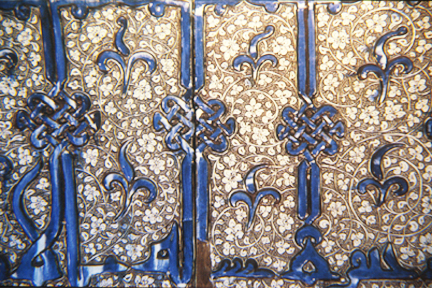The defining cultural force in the Middle East is Islam, and this faith began to spread in 622 CE with the arrival in Mecca and Medina of the prophet Muhammad (570-632 CE). Islam shares a belief with Christianity and Judaism in the Old Testament books of the Bible, and Muhammad is believed by Muslims to be the successor to Abraham and Jesus, and Muslims believe that the the word of God was revealed to him. He wrote that 'There is no God but Allah, and Muhammad is his prophet.' His writings were collected into what is known as the Koran (or Qur'an), the equivalent of the Bible to Muslims.
In addition to its use on pottery forms, the artisans of Kashan used luster on tile as well. On this tile frieze, in Kufic script is the inscription: 'In the name of God, the Merciful, the Compassionate.' This phrase starts almost every chapter of the Koran, and is spoken to this day by Muslim people before they begin any activity. Here, underglaze cobalt was used for the deep blues, and overglaze luster for the purplish-black arabesques.

Tile Frieze from Kashan, Fritware with Underglaze Cobalt and Overglaze Luster, 1280 CE


